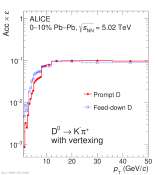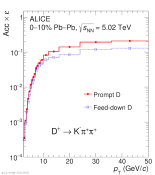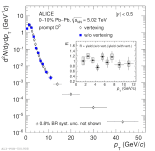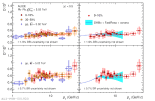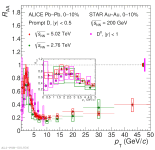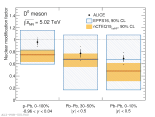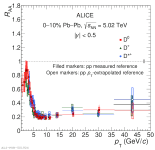Figures from paper submitted to Journal of High Energy Physics
Abstract:
The production of prompt D$^{0}$, D$^{+}$, and D$^{*+}$ mesons was measured at midrapidity (|y|<~ 0.5) in Pb-Pb collisions at the centre-of-mass energy per nucleon-nucleon pair $\sqrt{s_{\rm NN}}$ = 5.02 TeV with the ALICE detector at the LHC. The D mesons were reconstructed via their hadronic decay channels and their production yields were measured in central (0-10%) and semicentral (30-50%) collisions. The measurement was performed up to a transverse momentum ($p_{\rm T}$) of 36 or 50 GeV/$c$ depending on the D meson species and the centrality interval. For the first time in Pb-Pb collisions at the LHC, the yield of D$^0$ mesons was measured down to $p_{\rm T}$ = 0, which allowed a model-independent determination of the $p_{\rm T}$-integrated yield per unit of rapidity (d$N$/d$y$). A maximum suppression by a factor 5 and 2.5 was observed with the nuclear modification factor ($R_{\rm AA}$) of prompt D mesons at $p_{\rm T}$ = 6-8 GeV/$c$ for the 0-10% and 30-50% centrality classes, respectively. The D-meson $R_{\rm AA}$ is compared with that of charged pions, charged hadrons, and J/$\psi$ mesons as well as with theoretical predictions. The analysis of the agreement between the measured $R_{\rm AA}$, elliptic ($v_2$) and triangular ($v_3$) flow, and the model predictions allowed us to constrain the charm spatial diffusion coefficient $D_s$. Furthermore the comparison of $R_{\rm AA}$ and $v_2$ with different implementations of the same models provides an important insight into the role of radiative energy loss as well as charm quark recombination in the hadronisation mechanisms.
JHEP 01 (2022) 174
e-Print: arXiv:2110.09420 | PDF | inSPIRE


